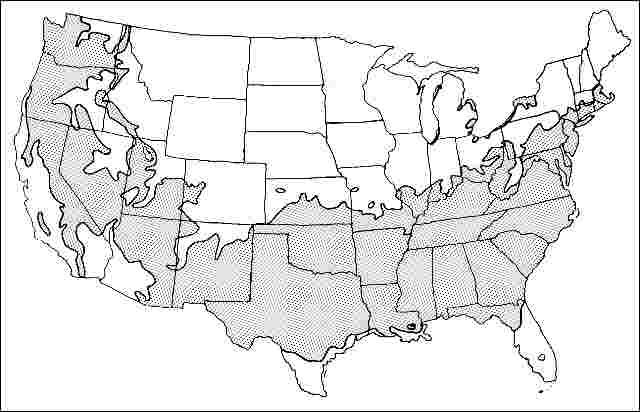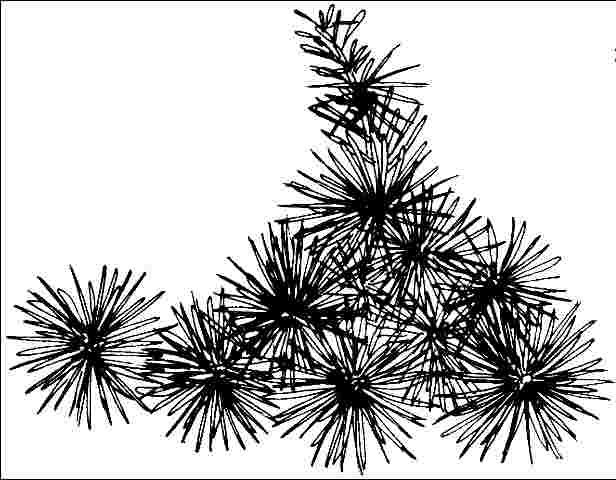Cedrus atlantica 'Glauca': Blue Atlas Cedar1
Introduction
A handsome evergreen with blue, bluish-green or light green foliage, 'Glauca' atlas cedar is perfect for specimen planting where it can grow without being crowded since the tree looks its best when branches are left on the tree to the ground. This shows off the wonderful irregular, open pyramidal form with lower branches spreading about half the height. It grows rapidly when young, then slowly, reaching 40 to 60 feet tall by 30 to 40 feet wide. The trunk stays fairly straight with lateral branches nearly horizontal. Allow plenty of room for these trees to spread. They are best located as a lawn specimen away from walks, streets, and sidewalks so branches will not have to be pruned. It looks odd if lower branches are removed. Older trees become flat-topped and are a beautiful sight to behold.

Credit: Ed Gilman
General Information
Scientific name: Cedrus atlantica
Pronunciation: SEE-drus at-LAN-tih-kuh
Common name(s): Blue atlas cedar
Family: Pinaceae
USDA hardiness zones: 6A through 8B (Fig. 2)
Origin: not native to North America
Invasive potential: little invasive potential
Uses: specimen; bonsai
Availability: not native to North America

Description
Height: 40 to 60 feet
Spread: 25 to 40 feet
Crown uniformity: irregular
Crown shape: pyramidal
Crown density: moderate
Growth rate: moderate
Texture: fine
Foliage
Leaf arrangement: spiral (Fig. 3)
Leaf type: simple
Leaf margin: entire
Leaf shape: needle-like (filiform)
Leaf venation: parallel
Leaf type and persistence: evergreen, needled evergreen
Leaf blade length: less than 2 inches
Leaf color: blue or blue-green
Fall color: no color change
Fall characteristic: not showy

Flower
Flower color: unknown
Flower characteristics: not showy
Fruit
Fruit shape: oval, cone
Fruit length: 3 to 6 inches
Fruit covering: dry or hard
Fruit color: brown
Fruit characteristics: does not attract wildlife; not showy; fruit/leaves not a litter problem
Trunk and Branches
Trunk/bark/branches: branches droop; not showy; typically one trunk; thorns
Pruning requirement: little required
Breakage: resistant
Current year twig color: green, brown
Current year twig thickness: medium
Wood specific gravity: unknown
Culture
Light requirement: full sun, partial sun, or partial shade
Soil tolerances: clay; sand; loam; slightly alkaline; acidic; well-drained
Drought tolerance: high
Aerosol salt tolerance: moderate
Other
Roots: not a problem
Winter interest: no
Outstanding tree: yes
Ozone sensitivity: unknown
Verticillium wilt susceptibility: resistant
Pest resistance: free of serious pests and diseases
Use and Management
Difficult to transplant, 'Glauca' atlas cedar should be planted from a container. Soil preference is for well-drained deep loam, on the acid side, but it can tolerate sandy or clay soils and alkaline soil if they are very well-drained. The tree looks its best when sheltered from strong winds but tolerates open conditions, and will grow in full sun or partial shade. Allow for plenty of soil space around the tree since growth will be poor in restricted soil space. Tolerates extensive drought only when grown in an area where roots can explore a large soil area. Performs well in all areas within its hardiness range. It may be suited for zone 9 in California and Florida.
Propagation is by seed.
'Pendula' has a very strong weeping habit but must be staked and trained to make a tree, 15 feet tall; 'Argentea' has silver, almost white foliage.
Pests and Diseases
No pests or diseases are of major concern. Generally free of insect pests and resistant to diseases, they may occasionally fall prey to tip blight, root rots (in poorly-drained soil) or black scale and the Deodar weevil. Usually no pest protection or control is necessary.
Sap-suckers are attracted to the trunk and often riddle it with small holes. This usually does little lasting harm to the tree.


